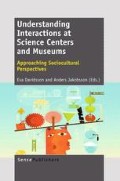Abstract
What an amazing project! How proud we were to contemplate the results and to present them to the visitors. It’s a project that got my students actively involved from the beginning given its inclusionary nature. To work with robots immediately got their attention. To work with aïbo was tempting too. The assembling and programming of the robots posed a real challenge and appeared to entail the kind of problem solving typically reserved for technology experts only. Those with less affinity in technology had the opportunity to be involved in the construction of a city making the project meaningful to all.
Access this chapter
Tax calculation will be finalised at checkout
Purchases are for personal use only
Preview
Unable to display preview. Download preview PDF.
REFERENCES
Bevan, B. with Dillon, J., Hein, G.E., Macdonald, M., Michalchik, V., Miller, D., Root, D., Rudder, L., Xanthoudaki, M., & Yoon, S. (2010). Making Science Matter: Collaborations Between Informal Science Education Organizations and Schools. A CAISE Inquiry Group Report. Washington, D.C.: Center for Advancement of Informal Science Education (CAISE).
Cervone, B. (2010). Powerful learning with public purpose. New Directions for Youth Development, 127, 37–50.
Chambers, J. M., Carbonaro, M., & Rex, M. (2007). Scaffolding knowledge construction through robotic technology: A middle school case study. Electronic Journal for the Integration of Technology in Education, 6, 55–70.
Daniels, H., Cole, M., & Wertsch, J. V. (Eds.) (2007). The Cambridge Companion to Vygotsky. New York: Cambridge University Press.
Daniels, H. (2001). Vygotsky and pedagogy. New York: Routledge Falmer Press.
Derry, J. S., Pea, R. D.; Barron, B.; Engle, R. A.; Erickson, F., Goldman, R., Hall, R., Koschmann, T., Lemke, J. L., Sherin, M. G., & Sherin, B. L., (2010). Conducting Video Research in the Learning Sciences: Guidance on Selection, Analysis, Technology, and Ethics. Journal of the Learning Sciences, 19(1), 3–53.
Engeström, Y, Engeström, R., & Suntio, A. (2002). Can a school community learn to master its own future? An activity-theoretical study of expansive learning among middle school teachers. In G. Wells & G. Claxton (Eds.), Learning for life in the 21st century (pp. 211–224). New York: Blackwell.
Engeström, Y. (1987). Learning by expanding: An activity-theoretical approach to developmental research. Helsinki, Finland: Orienta-Konsultit.
Engeström, Y., Miettinen, R., & Punamäki, R.-L. (Eds.) (1999). Perspectives on activity theory.
Cambridge, England: Cambridge University Press.
Jordan, B., & Henderson, A. (1995). Interaction analysis: Foundations and practice. The Journal of the Learning Sciences, 4(1), 39–103.
Leont’ev, A. N. (1981). The problem of activity in psychology. In J. V. Wertsch (Ed.), The concept of activity in soviet psychology (pp. 37–71). Armonk, NY: Sharpe.
Leont’ev, A.N. (1978). Activity, consciousness and personality. Englewood Cliffs, NJ: Prentice Hall.
Martin, L. M. W. (2007). An emerging research framework for studying free-choice learning and schools. In J. H. Falk, Dierking, L. D., & S. Foutz (Eds.), In principle, in practice: Museum as learning institution (pp./ 247–259). Lanham, MD: Alta Mira Press.
Petre, M., & Price, B. (2004). Using robotics to motivate ‘back door’ learning. Education and Information Technologies, 9(2), 147–158.
Rahm, J. (2006). A look at meaning making in science through School-Scientist-Museum Partnerships. The Canadian Journal of Science, Mathematics and Technology Education (Special Issue on Informal Science Education) 6(1), 47–66.
Rahm, J., & Hébert, M. (2008). “It made us learn so much more about science!” How innovative partnership projects among schools, museums, and scientists can make science museums accessible to poor inner-city youth. A. Meunier & A. Landry (Eds.), Research in Museum Education: Actions and Perspectives (pp. 117–141). Québec: Multimondes.
Resnick, M., Berg, R., & Eisenberg, M. (2000). Beyond black boxes: Bringing transparency and aesthetics back to scientific investigation. The Journal of the Learning Sciences, 9(1), 7–30.
Rusk, N., Resnick, M., Berg, R., & Pezalla-Granlund, M. (2008). New pathways in to robotics: Strategies for broadening participation. Journal of Science Education and Technology, February.
Author information
Authors and Affiliations
Editor information
Rights and permissions
Copyright information
© 2012 Sense Publishers
About this chapter
Cite this chapter
Rahm, J. (2012). Activity Theory as a Lens to Examine Project-Based Museum Partnerships in Robotics. In: Davidsson, E., Jakobsson, A. (eds) Understanding Interactions at Science Centers and Museums. SensePublishers. https://doi.org/10.1007/978-94-6091-725-7_10
Download citation
DOI: https://doi.org/10.1007/978-94-6091-725-7_10
Publisher Name: SensePublishers
Online ISBN: 978-94-6091-725-7
eBook Packages: Humanities, Social Sciences and LawEducation (R0)


